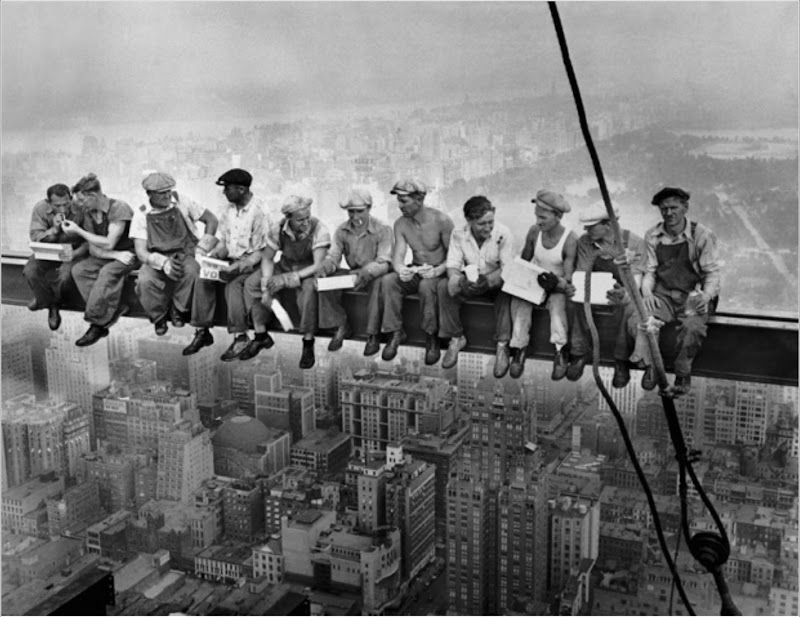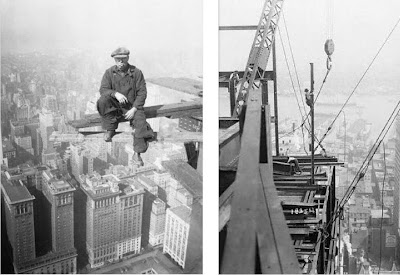 “Almuerzo en un rascacielos” es una de las fotografías más famosas de Charles C. Ebbets, todo un clásico de los pósters que te encuentras habitualmente en tiendas de decoración, librerías etc. La imagen fue tomada en el año 1932 durante la construcción del complejo de edificios comerciales Rockefeller Center, en la planta 69 del Edificio de General Electric y la publicó el New York Herald Tribune en el suplemento dominical .
“Almuerzo en un rascacielos” es una de las fotografías más famosas de Charles C. Ebbets, todo un clásico de los pósters que te encuentras habitualmente en tiendas de decoración, librerías etc. La imagen fue tomada en el año 1932 durante la construcción del complejo de edificios comerciales Rockefeller Center, en la planta 69 del Edificio de General Electric y la publicó el New York Herald Tribune en el suplemento dominical . En ella se ven cómo 11 obreros (al parecer, indios Mohawk e Irlandeses) están descansando sentados sobre una viga de acero a una altura de 244 mts, con la ciudad y el vacío bajo sus pies. Las medidas de seguridad brillan por su ausencia, al no tener ni redes, ni arneses, ni siquiera cascos, where workers take the danger as normal, risking their lives every moment, without any protection and it seems without the slightest concern for their part.
The photos caused a major impact, served to denounce the precarious working conditions of workers in this period of depression in the United States. Most photos are not prepared, are real and correspond to everyday scenes of the workers who participated in the construction of skyscrapers. These images not surprised by what happens in them, but impresses you what can happen.

Charles Ebbets (photographer) born in Alabama (1905-1978) and it was a passion for photography, at eight years old he bought his first camera at a local store, debiting the account that her mother had open, what was a good punishment, but ultimately did not return it and got away with it. In years 30 had already published his photos in the major newspapers in the U.S. and was well known for his graphic work, for which he was hired as director of photography at Rockefeller Center to document the construction of this complex.

Charles Ebbets (photographer) born in Alabama (1905-1978) and it was a passion for photography, at eight years old he bought his first camera at a local store, debiting the account that her mother had open, what was a good punishment, but ultimately did not return it and got away with it. In years 30 had already published his photos in the major newspapers in the U.S. and was well known for his graphic work, for which he was hired as director of photography at Rockefeller Center to document the construction of this complex.
These scenes of yesterday, unfortunately continue to be found without the need to go far, is easy to find someone standing on a deck, or scaffold, without the least fear or less protection you can avoid an accident.
Last week was the International Day for Safety and Health ( 28 April ) and served cold to see the previous year's statistics, where despite the downturn in economic activity and the lowest number of employees, fatal accidents increased over the previous year. The main cause of death in construction accident along 2008 were falls from height (42%), followed by impact or crushing deaths (22%). Between 36% remaining listed, mostly, deaths from abuse and those produced as a result of electric shock.
The entry into force in February 1996 Act Occupational Health and Safety was a step forward in terms of integration and Update on Safety Promotion and Health of Workers Preventive incorporating a treatment philosophy of Occupational Hazards and becoming a Statutory Instrument to improve .




Very interesting Jorge,
Sadly Spain is among the European countries with the highest rate of workplace accidents, led by the construction sector. It seems that much remains to be done
Everywhere baked beans.
Just like here.
Every time I see these pictures gives me a chill. My first thought is that it will fall into the void, but certainly, to see their faces, is something not arise as this work is part of daily life. It's amazing. I wonder how many would die in the construction of each skyscraper.
You have to frame these photos in the American context of the Great Depression. The crack of 29 marked the beginning of this debacle that reached its lowest point in the 32 (year of photos) and only recovered to levels before the 29 about 22 years later.
The construction of this and many other New York skyscrapers concentrated in those previous years of capitalist euphoria. Therefore it can be understood that these workers, despite the legend of the Mohawk-vertigo, may be of the lucky few to work even 244 meters. Without any security up and down either.
Health, friend.
It's funny to think that something that once they looked normal these workers now see it as a real outrage,times have changed and the way you see life also,very interesting and stunning black and white photos bring out the reality of the situation.
I'm surprised to see an architectural concerned about safety in the works, when it is an issue that your guild will never been interested…..I'm happy.
Although it is a subject I do not know much,I believe it is important that the developer is aware of the danger to their subordinates, up owing to compel compliance with the rules of occupational hazards,traffic likewise requires us to wear a seat belt and helmet on bikes…
It is very impressive to see these pictures where we ensenhan that the need to survive and keep our loved ones puts us above our fears. in anhos 30' the economic situation in the USA was so bad that if you managed to get a job for pay for long around of $1 Debias the day to care and take risks to make azanhas how are you passing the days that were converted into “normal” for these brave men.
It is very impressive to see these pictures where we ensenhan that the need to survive and keep our loved ones puts us above our fears. in anhos 30' the economic situation in the USA was so bad that if you managed to get a job for pay for long around of $1 Debias the day to care and take risks to make azanhas how are you passing the days that were converted into “normal” for these brave men.